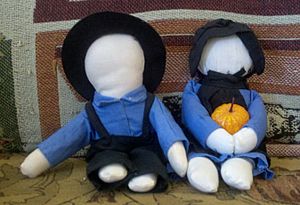Amish doll facts for kids
Amish dolls are a special kind of rag doll. They are a popular type of American folk art. These dolls first started as toys for children among the Old Order Amish people. Some Amish dolls have faces, but the most famous ones do not. This is to show that everyone is equal in the eyes of God.
Contents
What Makes Amish Dolls Special?
An Amish doll is usually a simple rag doll. It often does not have a face or hair. Many believe that a doll with a face looks too much like the outside world. This is not something the Amish usually accept. However, not all Amish dolls are faceless.
The clothes on Amish dolls look like what Amish children wear. Both boy and girl dolls are common. Amish children do not have many toys. So, both boys and girls play with these dolls. The fabrics used are always solid colors.
The doll's body is often made from white or cream fabric. This includes materials like unbleached muslin. The materials traditionally used were leftover pieces from clothes made for family members. In the past, faces were sometimes made from oilcloth. Dolls were traditionally stuffed with rags. Today, cotton or polyester stuffing is also common.
How Amish Dolls Are Made
Dolls can be sewn by hand or by machine. Amish people often use a foot-operated treadle sewing machine. This machine works without electricity.
Older Amish dolls sometimes have many layers of cloth on their head or body. If a doll got too dirty or worn out, its head, arms, and legs would be covered with fresh cloth. This made the doll look new again.
Collecting Old Amish Dolls
Very old Amish dolls that were played with by Amish children are highly sought after. They can be worth a lot of money, sometimes over US $1,000. However, many new dolls are made to look old. This has made the market for these dolls a bit tricky.
Amish Dolls and Tourists
People started to become very interested in collecting Amish crafts in the 1930s. In 1939, a professor named Cornelius Weygandt wrote about his collection. He had dolls from the Amish and Mennonite communities. He admired how carefully their clothes were made.
National advertisements for Amish dolls appeared in House & Garden magazine in 1941. Interestingly, these dolls often had faces. As more tourists visited Amish areas over the years, faceless dolls became common. You could often find them in souvenir shops. In 1955, an expert named John A. Hostetler noted this trend. He saw it as part of Amish culture becoming more commercial.
See also
 In Spanish: Muñeca amish para niños
In Spanish: Muñeca amish para niños


